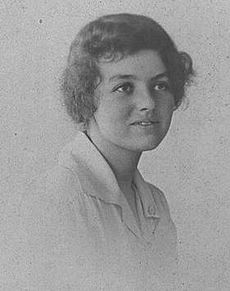Jean Curlewis facts for kids
Jean Curlewis (born February 7, 1898 – died March 28, 1930) was a talented Australian writer. She was the daughter of famous author Ethel Turner and lawyer Herbert Curlewis. Sadly, Jean fought tuberculosis for many years. She passed away when she was only 32 years old.
Jean Curlewis's Early Life
Jean Curlewis was born in Mosman, Australia. Her full name was Ethel Jean Sophia Curlewis. She grew up in a well-educated family. Her mother, Ethel Turner, wrote the very popular book Seven Little Australians. Her father, Herbert Curlewis, was a lawyer.
Jean went to school at Killarney, a Church of England Grammar School in Mosman. Later, she attended S.C.E.G.G.S. Darlinghurst. Jean was very close to her mother. Her family's love for books helped her become a smart and thoughtful young woman.
Jean cared a lot about helping others. In 1919, she volunteered to help nurses. This was during the Spanish 'flu epidemic in Sydney. It is thought that during this time, she might have caught tuberculosis. This illness sadly ended her life years later.
In 1923, Jean married Dr. Leo Charlton. They lived in London for two years while Leo studied more. Jean spent her last years in a family cottage in the Blue Mountains. She also stayed in hospitals as she battled her illness. She fought tuberculosis for almost ten years.
Jean Curlewis's Writing Career
Jean had a special friend and mentor, the poet Dorothea Mackellar. Dorothea encouraged Jean to write poetry. After Jean passed away, Dorothea wrote an article about her. She called Jean "the best kind of Australian." She praised Jean's clear thinking and strong feelings in her writing.
Like her famous mother, Jean started writing when she was young. At just 18, she helped her aunt Lilian write stories. These were "legends and native stuff" for a new children's magazine. After returning from England, Jean wrote articles for newspapers and magazines. She also wrote a lot for "Sunbeams." This was a children's section in The Sunday Sun newspaper. Her mother edited this section.
Jean's biggest dream was to become a respected novelist. She wrote for the fun The Sunshine Family book. But she was most interested in writing serious novels. These books had important messages hidden in exciting stories. Jean was a great storyteller. She wrote four different novels in her short life. Even with serious ideas, her books were light-hearted and never too serious. Each book showed parts of Australian life in the 1920s. These were things Jean herself had experienced.
Jean Curlewis's first novel was The Ship that Never Set Sail (1921). The title sadly hinted at Jean's own life. She died young, before she could fully develop her writing talent. But the title also had a deeper meaning in her stories. "The ship that never set sail" was a symbol. It showed how young people's dreams often meet the real world. This first novel was very personal to Jean. It had a gentle charm that her later books didn't have as much.
Her novel Drowning Maze (1922) starts like a school story. But it quickly turns into an exciting adventure. Jean's later novels often played with different story types. She used ideas from adventure writers like H. Rider Haggard and Rudyard Kipling. She also used exciting plot tricks. These included races against time, chases, and funny misunderstandings.
Jean Curlewis's Books
- The Ship That Never Set Sail (1921)
- Drowning Maze (1922)
- Beach Beyond (1923)
- The Dawn Man (1924)
- Verse Writing for Beginners (1925)
- Christmas in Australia – Art in Australia Ltd, Sydney (1928) – decorated by Adrian Feint
- The Sunshine Family: A Book of Nonsense for girls and Boys (1923) – with Ethel Turner


